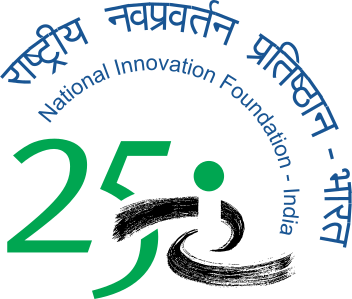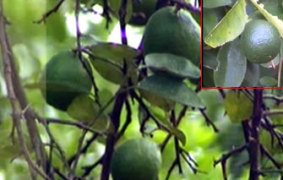New acid lime variety
Antony Samy (62) lives in Puliangudi village of Tirunelveli District, Tamil Nadu. He has two sons and one daughter. He has studied up to the eighth standard. His elder son is a graduate in Agriculture. Antony Samy owns 40 acres of irrigated land with three wells and boasts a monthly income of Rs.2, 00,000.
Puliangudi village is known for the cultivation of Acid lime. The climate, soil and marketing facilities are quite suitable for the cultivation of this crop, thus making this village the leader in acid lime cultivation.
Genesis
Antonysamy is the moving spirit of the Small Farmers Agricultural Engineering Service Centre and its activities. This organisation, which was founded by Gomathinayagam, a retired teacher, has been active in Puliangudi village of Tirunelveli-Kattabomman district since 1975. The centre has been instrumental in setting an example for the rest of Tamil Nadu that if farmers wish they could make the barren land bloom and mine gold from it without depending much on the government. The centre has less than 50 farmers as its members and most of them have very little formal education. But what is most impressive is that these farmers speak admirably of how Koreans and Israelites raise grape nurseries in mid chamber conditions, how they manure their vineyards and harvest 40 tonnes of the fruit from just one acre of land. When asked how they know all this, Samy replies coolly, “By listening to educated men and reading farm magazines.”
Besides organising seminars and debates on farming, the organisation subscribes to almost all the farm magazines in Tamil and “Kisan World” a farm journal in English. It employs a mechanic to attend to the repairing of the members’ pump sets and also provides them with a motor on nominal rent if theirs’ goes out of order. What makes its members enterprising is their readiness to experiment with what they read and hear about newer and better ways of farming in the light of experiments in countries like Korea, Japan and Israel.
In 1982, Antony Samy left seed production enterprise due to high input cost and started the cultivation of acid lime. Since 1962 he had been cultivating on a small scale, but from 1982 onwards he expanded his cultivation of acid lime to 30 acres of land and made a good profit out of it. Then he started facing problems like declining productivity, micronutrients deficiency and quick wilt problem in seedlings of acid lime; which led to large scale pruning of the crop. He found a deficiency of trace elements such as Zinc, Boron, Iron and Copper in spite of applying mineral fertilizers to the crop. So he rushed to the Indian Institute of Horticulture (IIHR), Haseragatta for technical guidance and there he met Dr. Edward Rajan, Soil Scientist who told him that the low productivity was due to the shallow root system of citrus plants. He also told him about the germplasm collection (nearly 280 accessions) of acid lime in the research institute and advised him to graft by using locally available rootstock.
Accordingly Antony Samy purchased a few rootstocks from IIHR and raised the seedlings in his farm. From these he selected rough-wild lemon rootstock. In the mean time he evaluated and selected two scions out of thirteen mother plants with good performance, which he had maintained in his farm over many years of observations. He grafted this scion to wild lemon rootstock. He measured the tap root length of the new variety and confirmed that the desirable characteristics and vigour of the citrus trees are due to the deep root system. He planted country onion and Giant African marigold around each plant to repel nematodes and other foliar pests. There were no intercrops and the fields were weeded regularly. He used organic pest repellents once a fortnight followed by a spray of fish ensilage and cow’s urine to promote plant growth. He added about 7kg compost per plant, every six months, in the initial stages of crop growth and this was gradually increased to 10 kg per tree from the second year onwards. He used Neem cake, cow urine and Notchi (Vitex negundo) for control of foliage caterpillar. He also sprayed ‘Panchakavya’ as liquid fertiliser during the time of flowering i.e. October- November.
He planted the first batch of 120 plants using wild citrus rootstock in1996. In the second batch he used 200 wild citrus rootstocks grafted with the first generation citrus plants (F1 obtained by grafting wild citrus with high yielding Edward lemon). The second-generation plants have maintained the good qualities of the first. Antonysamy is now planning for the third generation grafting by using wild citrus rootstock of second generation-grafted plants. There is fruiting all year around in his farm and peak yields are obtained in April-May and August–September when there are premium prices in the market.
The cost of cultivation of acid lime works out to Rs.37, 500 per hectare in the first year, and the cost for maintenance in the second and subsequent years would be about Rs.15, 000 per hectare. The trees may be kept in good stead for about 25 years. The market price for the fruits varies from Rs.200 per 1000 fruits in peak season to Rs.500 in the off-season. Initially he had a lot of debt due to adopting organic farming practices but he successfully repaid the entire loan only with the profit out of bumper crops of acid lime over the last 3 – 5 years.
Apart from this he designed his own drip system to deliver four litres of water per day per plant in the initial stages of growth. The water delivery is gradually increased to 30litres per day as the crop reaches peak yield from the fifth year of planting. He suggests increasing it to 100 litres a day during peak summer.
Mass Multiplication and propagation of the new citrus variety After seeing the success of his new variety, Antonysamy wanted to market it. Till date he has raised 1000 grafted plants by using wild rootstock. He found out that he would not be able to supply the high market demand and therefore he decided to give this propagation work to his friend Vijay Anand who has established a mother unit for mass multiplication and propagation of the new citrus variety. Antonysamy is also trying budding method of reproduction instead of grafting to undertake mass propagation.
Characteristics of the new citrus variety
The grafted plants are not only vigorous in growth but also disease free, pest resistant and bear a higher number of violet-tinged flowers in each leaf axis on lengthy bracts. They also have the desirable characteristics of being shorter in stature and have a larger surface area for exposure to sunlight. These plants are drought tolerant and resistant to quick wilt. The water requirement is 20 % less than that of the local variety. 90 % of the fruits produced are first grade fruits compared to only 60 % of the fruits of the most popular variety. The new variety comes to bearing from the 3rd year onwards as compared to the popular variety which comes to bearing from the 5th year onwards. Only 2 % of the twigs are removed as against 15 -16% of twigs which need to be pruned at the end of each season in the popular variety. The yield per hectare is 35,500 kg in comparison with the popular variety of the region which has a yield of 20,500-kg. The productivity is 4000 fruits per tree per year compared to 2500-3000 fruits in ordinary variety and it takes 135 days to mature (from flowering to harvest, in summer) and 150 days in winter. The root system is highly developed, penetrating the soil up to five to six feet in depth compared to a maximum of two feet in the ordinary grafted variety. The lateral roots (shallow adventitious roots) are also well developed in the new variety. The fruits are bigger, more juicy and suitable for pickle and processing industries.
Trying the new variety under dry land conditions
Antonysamy wanted to cultivate this new variety under natural conditions, without any watering. With this aim he has been growing a few plants without watering from 1998 onwards .His experiment worked and the plants are bearing fruits without watering. But the yield of fruits is around 1500-2000 compared to 5000, when they get watered regularly.
Searching for other good root stock
Appreciating the successful outcome of using wild citrus rootstock, he started searching for other varieties of wild citrus plant stock, even from other states. He went to Andhra Pradesh and procured wild citrus plants from Railway Godur village. Now he is growing different types of rootstock and continuing his experiments.
Other successful experiments…
Innovative grafting in Amla
He gathered different wild amla varieties from the Western ghats and raised the seedlings in his farm. These wild varieties were tall in stature and the fruits were not of uniform size. This lead to difficulty in harvesting (because of unusual height) and fetched low prices in the market. So he grafted improved varieties of amla such as “NA7” and “Kanchan” with the wild amla variety root stock. Then again he did top work with the graft with well performed local varieties as scion. The resultant grafted plant is of short stature and bears uniform sized fruits through out the year. This new variety can be used for high density planting, because of its short stature. Harvesting of the fruits is also easy. The tree started yielding two years after top working. On an average each tree yields about 60 kg of fruits in a year. The fruits were sold at Rs.12 per kg in the local market. This experiment is in the initial stage and evaluation is going on.
Switching over to Organic Farming …
In the late 1950s he used only inorganic fertilizers for farming. In 1972 he started seed production of crops such as different varieties of paddy, hybrid cotton, tomato and bajra. During that time he earned a lot of money. He had the parent line of bajra 5141A and distributed seeds to National Seed Corporation, MAHYCO, EID Parry and SPIC. In 1982- 1983 he noticed that the fertilizer requirement had increased up to 600kg/acre. But even with this input, there was a drastic reduction in the yield and quality which in turn lead to great loss to farmers. He observed that the plants near the compost pit were healthy and produced fertile pollen grains and this inspired him to practice organic farming in his field. He started using 100% organic manure/inputs. Currently he also cultivates sugarcane, bajra, pulses and fodder crop for animals. He also prepares herbal remedies for control of crop pests on his own.
Antonysamy has received a certificate from the Indian Society for Certification of Organic Products (ISCOP), Coimbatore which declares that they have inspected his Agricultural Farm and have found it in accordance with the standards of National Programme for Organic Production (NPOP) of Government of India and monitored by Indian Society for Certification of Organic Products.








